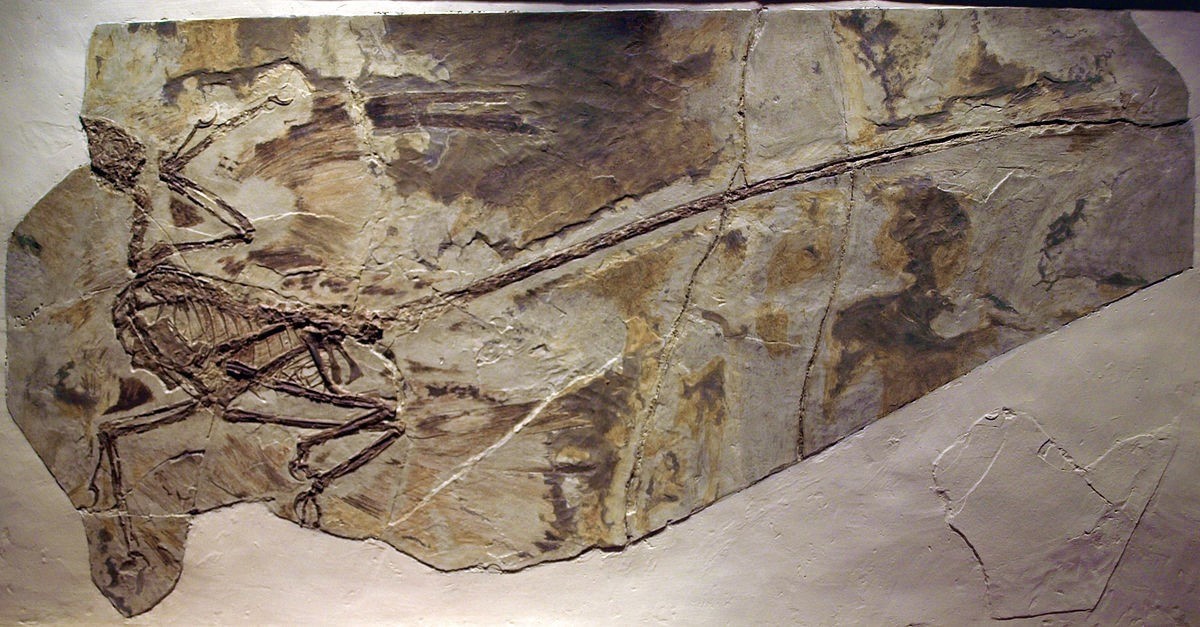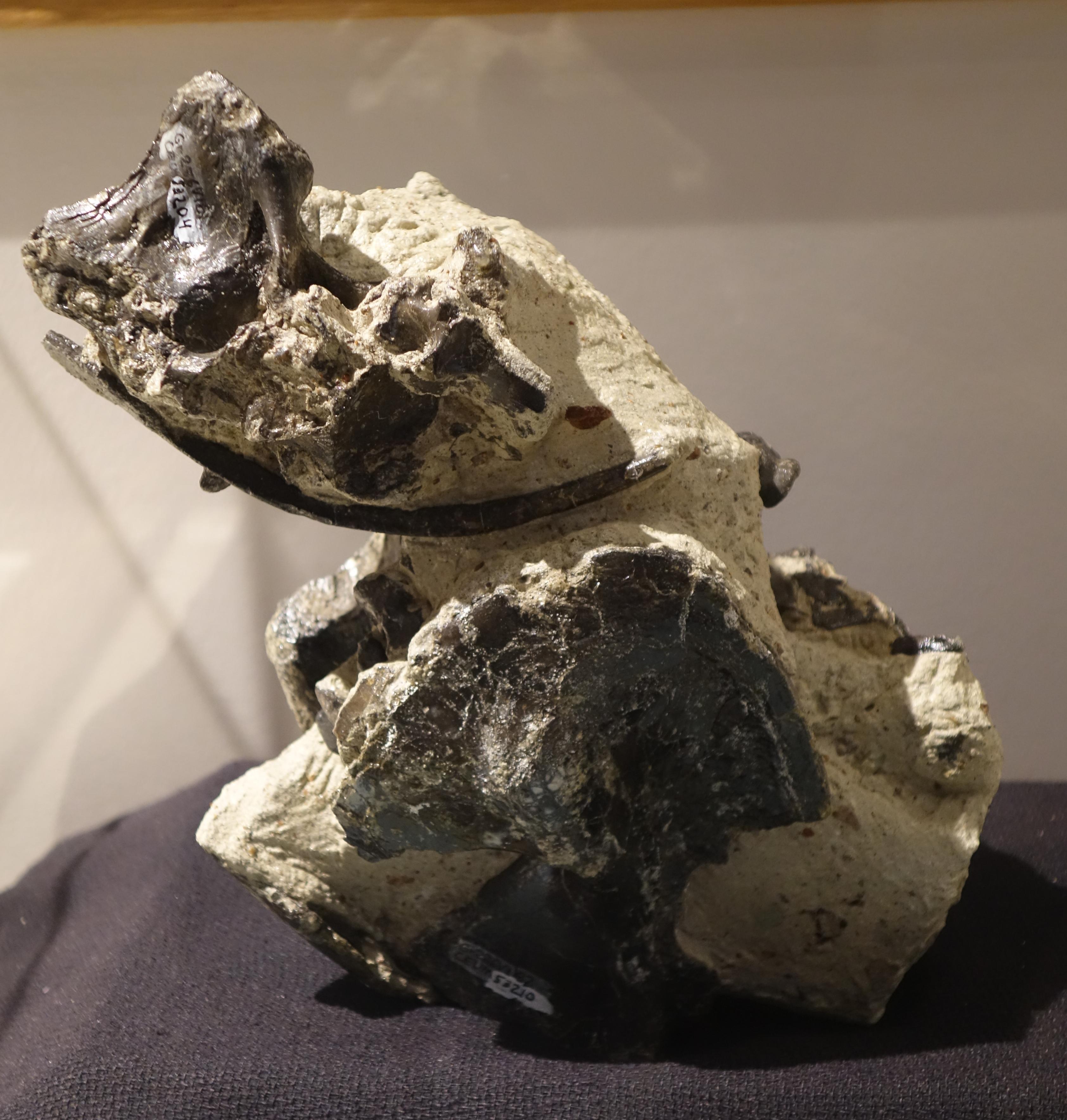|
Eshanosaurus
''Eshanosaurus'' is a genus of a dinosaur from the early Jurassic Period. It is known only from a fossil partial lower jawbone, found in China. It may be a therizinosaurian, and if so the earliest known coelurosaur. Discovery and naming The type species, ''Eshanosaurus deguchiianus'', was described by Xu Xing, Zhao, and James M. Clark in 2001. The generic name is derived from Eshan. The specific name honours Hikaru Deguchi who convinced Xu that he should study dinosaurs. The type specimen, consisting of three fragments of a fossilized left lower jaw and teeth, was uncovered in the Dull Purplish Beds of the Lower Lufeng Formation in Yunnan, dating to about 196 million years ago (Hettangian stage). The specimen is in the collection of the Institute of Vertebrate Paleontology and Paleoanthropology in Beijing, where it is catalogued under accession number IVPP V11579. Classification The authors who initially described the fossil, classified ''Eshanosaurus'' as a member of the ... [...More Info...] [...Related Items...] OR: [Wikipedia] [Google] [Baidu] |
Therizinosaur
Therizinosaurs (once called segnosaurs) were large herbivorous theropod dinosaurs whose fossils have been found across the Early to Late Cretaceous deposits in Asia and North America. Various features of the forelimbs, skull and pelvis unite these finds as both theropods and maniraptorans, close relatives to birds. The name of the representative genus, ''Therizinosaurus'', is derived from the Greek (, 'to reap' or 'scythe')Translated paper and (, 'lizard'). The older representative, ''Segnosaurus'', is derived from the ('slow') and the Greek . History of research [...More Info...] [...Related Items...] OR: [Wikipedia] [Google] [Baidu] |
Therizinosauroidea
Therizinosaurs (once called segnosaurs) were large herbivorous theropod dinosaurs whose fossils have been found across the Early to Late Cretaceous deposits in Asia and North America. Various features of the forelimbs, skull and pelvis unite these finds as both theropods and maniraptorans, close relatives to birds. The name of the representative genus, '' Therizinosaurus'', is derived from the Greek (, 'to reap' or 'scythe')Translated paper and (, 'lizard'). The older representative, ''Segnosaurus'', is derived from the ('slow') and the Greek . History of research [...More Info...] [...Related Items...] OR: [Wikipedia] [Google] [Baidu] |
Lower Lufeng Formation
The Lufeng Formation (formerly Lower Lufeng Series) is a Lower Jurassic sedimentary rock formation found in Yunnan, China. It has two units: the lower Dull Purplish Beds/Shawan Member are of Hettangian age, and Dark Red Beds/Zhangjia'ao Member are of Sinemurian age.Luo, Z., and X.-C. Wu. 1994. The small tetrapods of the Lower Lufeng Formation, Yunnan, China; pp. 251–270 in N. C. Fraser and H.-D.Sues (eds.), In the Shadow of the Dinosaurs. Cambridge University Press, New York It is known for its fossils of early dinosaurs. The Dull Purplish Beds have yielded the possible therizinosaur ''Eshanosaurus'', the possible theropod ''Lukousaurus'', and the "prosauropods" "Gyposaurus" ''sinensis'', '' Lufengosaurus'', ''Jingshanosaurus'', and '' Yunnanosaurus''. Dinosaurs discovered in the Dark Red Beds include the theropod ''Sinosaurus triassicus'', the "prosauropods" "Gyposaurus", ''Lufengosaurus'', and ''Yunnanosaurus'', indeterminate remains of sauropods, and the early armored ... [...More Info...] [...Related Items...] OR: [Wikipedia] [Google] [Baidu] |
Xu Xing (paleontologist)
Xu Xing (; born July 1969) is a Chinese paleontologist who has named more dinosaurs than any other living paleontologist. Such dinosaurs include the Jurassic ceratopsian '' Yinlong'', the Jurassic tyrannosauroid ''Guanlong'', the large oviraptorosaur ''Gigantoraptor'', and the troodontid ''Mei''. Biography Xing was born in Xinjiang, China, in 1969. A graduate from the department of geology of Peking University, he is currently a researcher at the Institute of Vertebrate Paleontology and Paleoanthropology of the Chinese Academy of Sciences in Beijing. He had originally planned to become an economist. However, he was assigned to the department of geology by the Chinese authorities. He graduated in 1995, and claims inspiration from Roy Chapman Andrews Roy Chapman Andrews (January 26, 1884 – March 11, 1960) was an American explorer, adventurer and naturalist who became the director of the American Museum of Natural History. He led a series of expeditions through the politi ... [...More Info...] [...Related Items...] OR: [Wikipedia] [Google] [Baidu] |
Maniraptora
Maniraptora is a clade of coelurosaurian dinosaurs which includes the birds and the non-avian dinosaurs that were more closely related to them than to '' Ornithomimus velox''. It contains the major subgroups Avialae, Deinonychosauria, Oviraptorosauria and Therizinosauria. ''Ornitholestes'' and the Alvarezsauroidea are also often included. Together with the next closest sister group, the Ornithomimosauria, Maniraptora comprises the more inclusive clade Maniraptoriformes. Maniraptorans first appear in the fossil record during the Jurassic Period (see '' Eshanosaurus''), and survive today as living birds. Description Maniraptorans are characterized by long arms and three-fingered hands (though reduced or fused in some lineages), as well as a "half-moon shaped" (semi-lunate) bone in the wrist ( carpus). In 2004, Tom Holtz and Halszka Osmólska pointed out six other maniraptoran characters relating to specific details of the skeleton. Unlike most other saurischian dinosaurs, ... [...More Info...] [...Related Items...] OR: [Wikipedia] [Google] [Baidu] |
Beipiaosaurus
''Beipiaosaurus'' is a genus of therizinosauroid theropod dinosaurs that lived in Asia during the Early Cretaceous in the Yixian Formation. The first remains were found in 1996 and formally described in 1999. Before the discovery of '' Yutyrannus'', they were among the heaviest dinosaurs known from direct evidence to be feathered. ''Beipiaosaurus'' is known from three reported specimens preserving numerous impressions of feather structures that allowed to determine the feathering color which turned out to be brownish. They were relatively small-sized therizinosaurs, measuring long and weighing about in contrast to the advanced and giant ''Segnosaurus'' or ''Therizinosaurus''. The necks of ''Beipiaosaurus'' were shorter than in most therizinosaurs, whose are characterized by elongated necks adapted for high-browsing. Also, their feet configuration differs from therizinosaurids, having a generic three-toed pes instead of four as seen in other members. The exact classification ... [...More Info...] [...Related Items...] OR: [Wikipedia] [Google] [Baidu] |
Archaeopteryx
''Archaeopteryx'' (; ), sometimes referred to by its German name, "" ( ''Primeval Bird''), is a genus of bird-like dinosaurs. The name derives from the ancient Greek (''archaīos''), meaning "ancient", and (''ptéryx''), meaning "feather" or "wing". Between the late 19th century and the early 21st century, ''Archaeopteryx'' was generally accepted by palaeontologists and popular reference books as the oldest known bird (member of the group Avialae). Older potential avialans have since been identified, including '' Anchiornis'', '' Xiaotingia'', and '' Aurornis''. ''Archaeopteryx'' lived in the Late Jurassic around 150 million years ago, in what is now southern Germany, during a time when Europe was an archipelago of islands in a shallow warm tropical sea, much closer to the equator than it is now. Similar in size to a Eurasian magpie, with the largest individuals possibly attaining the size of a raven, the largest species of ''Archaeopteryx'' could grow to about in ... [...More Info...] [...Related Items...] OR: [Wikipedia] [Google] [Baidu] |
Falcarius
''Falcarius'' (meaning "sickle cutter") is a genus of primitive therizinosaur dinosaur that lived during the Early Cretaceous period in what is now North America. Its remains were first collected in the Cedar Mountain Formation in 1999, with subsequent findings made during the 2000s. The genus is known from multiple specimens ranging from immature to fully-grown individuals. ''Falcarius'' was a long bipedal herbivore with a small head and an elongated neck and tail. Unlike advanced therizinosaurs, ''Falcarius'' had a propubic pelvis and three-toed feet with a reduced hallux (first digit). ''Falcarius'' is the basalmost known definitive therizinosaurian genus, and has been considered a transitional form connecting the typical theropod bodyplan to the unusual morphology of Therizinosauridae. Its description in 2005, following that of the basal therizinosauroid ''Beipiaosaurus'' from the Early Cretaceous of China in 1999, helped clarify the early evolution of the Therizinosauria ... [...More Info...] [...Related Items...] OR: [Wikipedia] [Google] [Baidu] |
Early Jurassic
The Early Jurassic Epoch (in chronostratigraphy corresponding to the Lower Jurassic Series) is the earliest of three epochs of the Jurassic Period. The Early Jurassic starts immediately after the Triassic-Jurassic extinction event, 201.3 Ma (million years ago), and ends at the start of the Middle Jurassic 174.1 Ma. Certain rocks of marine origin of this age in Europe are called "Lias" and that name was used for the period, as well, in 19th-century geology. In southern Germany rocks of this age are called Black Jurassic. Origin of the name Lias There are two possible origins for the name Lias: the first reason is it was taken by a geologist from an English quarryman's dialect pronunciation of the word "layers"; secondly, sloops from north Cornish ports such as Bude would sail across the Bristol Channel to the Vale of Glamorgan to load up with rock from coastal limestone quarries (lias limestone from South Wales was used throughout North Devon/North Cornwall as it conta ... [...More Info...] [...Related Items...] OR: [Wikipedia] [Google] [Baidu] |
Cladistic
Cladistics (; ) is an approach to biological classification in which organisms are categorized in groups (" clades") based on hypotheses of most recent common ancestry. The evidence for hypothesized relationships is typically shared derived characteristics (synapomorphies'')'' that are not present in more distant groups and ancestors. However, from an empirical perspective, common ancestors are inferences based on a cladistic hypothesis of relationships of taxa whose character states can be observed. Theoretically, a last common ancestor and all its descendants constitute a (minimal) clade. Importantly, all descendants stay in their overarching ancestral clade. For example, if the terms ''worms'' or ''fishes'' were used within a ''strict'' cladistic framework, these terms would include humans. Many of these terms are normally used paraphyletically, outside of cladistics, e.g. as a ' grade', which are fruitless to precisely delineate, especially when including extinct species. ... [...More Info...] [...Related Items...] OR: [Wikipedia] [Google] [Baidu] |
Ghost Lineage
A ghost lineage is a hypothesized ancestor in a species lineage that has left no fossil evidence yet can be inferred to exist because of gaps in the fossil record or genomic evidence. The process of determining a ghost lineage relies on fossilized evidence before and after the hypothetical existence of the lineage and extrapolating relationships between organisms based on phylogenetic analysis. Ghost lineages assume unseen diversity in the fossil record and serve as predictions for what the fossil record could eventually yield; these hypotheses can be tested by unearthing new fossils or running phylogenetic analyses. Ghost lineages and Lazarus taxa are related concepts, as both stem from gaps in the fossil record. A ghost lineage is any gap in a taxon's fossil record, with or without reappearance, while a Lazarus taxon is a type of ghost lineage wherein a species is believed to have gone extinct due to an absence in the fossil record, but then reappears after a period of time. Exa ... [...More Info...] [...Related Items...] OR: [Wikipedia] [Google] [Baidu] |










